Selected colour swatches
You can order up to 20 colour swatchesHow to paint a door

Sugar Soap

Sandpaper

Drop sheet

Paint stirrer

65mm paint brush
Doorways are the welcome into a home or room, and a fresh paint job gives tired entryways an instant lift. Our step-by-step process will show you how to get a pro finish that will stand the test of time.
While you can paint a door in situ, having it on a flat surface will make things easier and ensure a smooth finish. Take the door off its hinges and lay it across a couple of sawhorses or chairs. Remove handles and any other door furniture. Wash the surface with sugar soap to remove grease, grime and dirt. Fill any cracks or dings. If the door has been previously painted with enamel, lightly sand until the shine is removed. See more painting prep tips here.
If you’re painting bare timber, or the surface is stained or damaged, you’ll need an extra layer to prime the surface. British Paints PREP 4in1 Water Based combines the functions of sealer, primer, undercoat and stain-blocker in one convenient product.
British Paints H2O Enamel Semi Gloss is the pick for doors. It’s what you choose when a pro-smooth, tough finish is required. (See more about enamel paints here.) Or if your door is in good shape, you can save time with British Paints Paint & Prime Doors, Windows & Trim. Stir the paint with a flat stirrer or old ruler. Paint quickly using long strokes (no dabbing!).
Painting a decorative door? Paint the mullions first — the raised sections in the middle. Then paint the main panels, followed by the rails at the top and bottom. Finish off by painting the stiles (on the sides) and finally the edges.
Allow a minimum two hours between coats. Give the door a light sand before applying the second coat. Don’t use any pressure — let the paper do the work. Make sure you remove all sanding residue before painting.
You’ll need to wait at least 24 hours before turning your door to do the other side. If you want to paint both sides in a day, insert two screws partway into the top of the door, and one in the centre at the bottom of the door, and use these to rest the door on the saw tables. You can revolve the door before it’s dry by holding the two screws at the top.
Next Step
Ready to paint the door frame and the rest of your trims to match? See our tips HERE.





